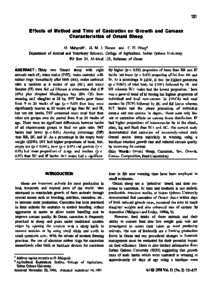Document
Effects of method and time of castration on growth and carcass characteristics of Omani sheep.
Identifier
DOI: 10.5713/ajas.1998.121
Source
Asian-Australasian Journal of Animal Sciences. v. 11, 2, p. 121-127
Contributors
Horton, G. M. J., Author
Olvey, F. H., Author
Country
Korea
City
Gwangpyeong
Publisher
Asian-Australasian Association of Animal Production Societies.
Gregorian
1998-04-01
Language
English
Subject
English abstract
Thirty two Omani sheep with eight animals each of; intact males (INT), males castrated with rubber rings immediately after birth (RR), males castrated with a burdizzo at 8 weeks of age (BC) and intact females (IF) were fed ad libitum a concentrate diet (CP 16%) plus chopped Rhodesgrass hay (8% CP) from weaning until slaughter at 28 kg. INT lambs grew faster from 9 to 20 weeks of age (p 0.05) thus they were significantly heavier at 20 weeks of age than BC and IF, but not RR lambs. INT consumed more total feed than other sex groups over the period from 9 to 20 weeks of age. There were no significant differences between lambs of all experimental groups in feed per gain ratio. INT lambs had lower (p 0.01) dressing percentage (DP) than RR, BC and IF. As a percentage in the empty body weight (EBW), INT had higher proportions of head, feet, empty gut (p 0.001), liver (p 0.05) and genitals (p 0.05) but lower proportions of lungs and trachea (p 0.05) than BC and IF lambs. INT males had a significantly higher (p 0.05) proportion of bone than RR and IF lambs but lower (p 0.05) proportion of fat than RR and IF. As a percentage in EBW, IF had the highest protortion (p 0.001) of total body fat (TBF) followed by BC and RR whereas INT males had the lowest proportion. There was a general trend of IF having the highest proportion of individual and total non-carcass fat (TNCF) and total carcass fat (TCF) followed by BC and RR lambs whereas INT lambs had the lowest protortions of individual carcass and non-carcass fat depots. There were only few sex or castration effects on carcass tissue distribution. IF had higher proportions of intermuscular fat in the chuck, plate, leg and flank than INT and BC. The current study demonstrated that castration of intensively-raised male Omani native sheep especially at weaning using a burdizzo retarded growth rate and reduced carcass quality by increasing fat content.
ISSN
1011-2367
Category
Journal articles


